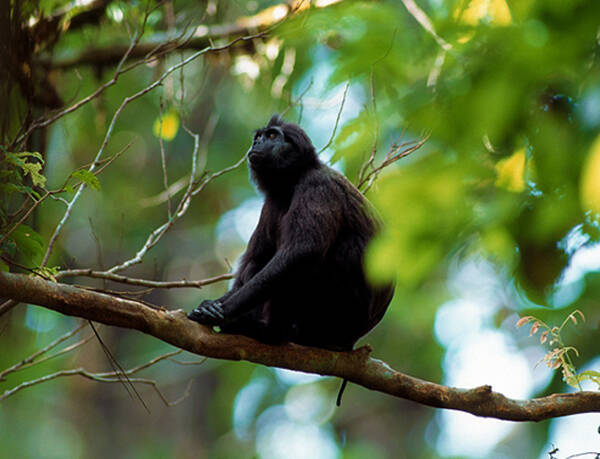Simias concolor
IUCN
LCBasic Information
Scientific classification
- name:Simias concolor
- Scientific Name:Simias concolor,Pig-tailed langur,Pig-tailed langur, Bagai Island langur
- Outline:Primates
- Family:Cercopithecidae P.Langur
Vital signs
- length:46-55cm
- Weight:7.1-8.7kg
- lifetime:No verification information
Feature
Upturned nose, pig tail
Distribution and Habitat
It is found only in the Mentawai Islands, west of Sumatra, Indonesia. Especially in North and South Pagai.
It inhabits tropical rainforests, including hillsides of primary forests, swamps and mangroves. This species is completely arboreal and only comes down from the trees when disturbed.
Appearance
The pig-tailed langur is a leaf-eating monkey, males are 49-55 cm long and weigh about 8.7 kg; females are 46-55 cm long and weigh 7.1-8.7 kg. The tail is 14-15 cm long, the only species of langur with a tail much shorter than the body. Males are slightly heavier. In addition to the pig-tail-like tail, another prominent feature is the upturned nose. Most pig-tailed langurs are black, but some (1/4 or 1/3) are creamy white.
There are two subspecies, the nominate subspecies and the Siberut subspecies. The fur color varies between species, most pig-tailed langurs are black or dark gray, but some (1/4 or 1/3) are cream or light yellow. The pig-tailed langur has an equal length and shorter tail than other primates. Adult pig-tailed langurs have a black face and a small nose. The nominate subspecies has a dark brown fur, while the Siberut subspecies has light spots on the shoulders and upper back. The tail of this species is not only short, but also hairless, except for a small amount of
Details
Pig-tailed langur (Simias concolor) has two subspecies. Pig-tailed langurs are related to other langurs and proboscis monkeys; all belong to the primate family Cercopithecidae. The scientific name of the pig-tailed langur, Simias concolor, was named by American zoologist and botanist Gerrit Smith Miller in 1903.

Pig-tailed langurs are more ground-dwelling than most langurs. In some areas, they live in pairs; in other areas, they live in groups consisting of a male and several females. They are diurnal and arboreal, rarely coming to the ground. They live in small groups of about 3-8 members, including a male, one or more females and their young. They mainly eat leaves, fruits and strawberries.
Pig-tailed langurs are diurnal social animals with territories ranging from 6,600 to 202,000 square meters. However, during encounters with other groups at the edge of neighboring territories, males will make loud calls and then return to their own territories with other members. Chasing and fighting are usually not observed in these encounters. Communication between individuals and groups is achieved by emitting a series of sounds that can be transmitted at least 500 meters in the rainforest. The purpose of the vocalizations is believed to be to maintain family structure and boundaries. Males emit loud nasal barks and females emit sharp calls. It is also likely that chemical signals are widely used in the communication of reproductive status, while vision and touch are also important.
Pig-tailed langur males have been observed to participate in displays of strength, including jumping and running through trees to attract mates. Their social groups consist of one male and up to 4 females, and these groups can consist of an adult couple and their children, or a single adult pair. The mating system is polygamous. Family members remain very close, rarely exceeding 5 meters. They limit vocal communication to only when designating group boundaries and as a warning to predators. One young is born per litter, in 6-7 months. They nurse and remain close to their young for about a year. Although males do not provide as much care as females, they do protect their young from other groups.
Pig-tailed langurs are primarily threatened by heavy hunting and commercial logging, and are also threatened by land conversion for oil palm plantations, deforestation and exploitation by local people. In addition, local rituals and taboos that previously regulated hunting have been replaced by Christianity. Pig-tailed langurs are the preferred game species of most Mentawai hunters. In 1989, it was estimated that twice as many pig-tailed langurs were killed by hunters each year as the number of newborns. The animals are also sometimes traded as pets.
The pig-tailed langur is listed in Appendix I of CITES and is protected under Indonesian law. It exists only in one official protected area, Siberut National Park, and no individuals are kept in captivity.
Listed in the 2016 IUCN Red List of Threatened Species, ver 3.1 - Critically Endangered (CR).
Listed in Appendix I, II and III of the Convention on International Trade in Endangered Species of Wild Fauna and Flora (CITES), 2019 edition.
Protect wild animals and stop eating game.
Maintaining ecological balance is everyone's responsibility!








